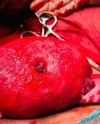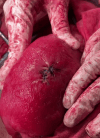Incidental Diagnosis of Uterine Perforation During Lower Segment Caesarean Section: A Rare Obstetric Complication
- PMID: 40525055
- PMCID: PMC12168867
- DOI: 10.7759/cureus.84223
Incidental Diagnosis of Uterine Perforation During Lower Segment Caesarean Section: A Rare Obstetric Complication
Abstract
This case report describes the incidental finding of uterine perforation during lower segment cesarean section (LSCS) in a 30-year-old woman, G2A1 with a history of a missed abortion. The antenatal period of the current pregnancy was uncomplicated. The patient presented at 39 weeks with complaints of leaking. A detailed examination revealed thick meconium, leading to the diagnosis of premature rupture of membranes. In response to the urgency posed by potential fetal distress, an emergency LSCS was performed. Post-delivery, an incidental intraoperative finding revealed a 2 cm circular uterine perforation at the fundus, actively bleeding. Swift surgical intervention utilizing absorbable suture polyglactin 2.0 achieved successful hemostasis, preventing potential severe complications such as postpartum endometritis and peritonitis. This case highlights the importance of vigilance and prompt intervention in managing unexpected obstetric complications during LSCS.
Keywords: dilatation and curettage; missed abortion; perforation; polyglactin; premature rupture of membranes.
Copyright © 2025, Chauhan et al.
Conflict of interest statement
Human subjects: Consent for treatment and open access publication was obtained or waived by all participants in this study. Conflicts of interest: In compliance with the ICMJE uniform disclosure form, all authors declare the following: Payment/services info: All authors have declared that no financial support was received from any organization for the submitted work. Financial relationships: All authors have declared that they have no financial relationships at present or within the previous three years with any organizations that might have an interest in the submitted work. Other relationships: All authors have declared that there are no other relationships or activities that could appear to have influenced the submitted work.
Figures
Similar articles
-
A Rare Occurrence of Uterine Perforation Following the Dilation and Curettage for Missed Abortion.Cureus. 2024 Sep 24;16(9):e70079. doi: 10.7759/cureus.70079. eCollection 2024 Sep. Cureus. 2024. PMID: 39449922 Free PMC article.
-
Uterine sacrifice in obstetric emergencies case series: Complex cases of fetal distress, labor challenges, and life-saving interventions.SAGE Open Med Case Rep. 2024 Jul 24;12:2050313X241261487. doi: 10.1177/2050313X241261487. eCollection 2024. SAGE Open Med Case Rep. 2024. PMID: 39055673 Free PMC article.
-
Intra-operative Diagnosis of Lower Segment Scar Dehiscence in a Second Gravida After One Previous Lower Segment Cesarean Section: Should We Advocate for Routine Antenatal Uterine Scar Thickness Testing?Clin Med Insights Case Rep. 2023 Mar 29;16:11795476231164379. doi: 10.1177/11795476231164379. eCollection 2023. Clin Med Insights Case Rep. 2023. PMID: 37009324 Free PMC article.
-
Uterine rupture in pregnancy after an intervention complicated by uterine perforation: Case report and systematic review of literature.Sex Reprod Healthc. 2019 Mar;19:9-14. doi: 10.1016/j.srhc.2018.11.001. Epub 2018 Nov 8. Sex Reprod Healthc. 2019. PMID: 30928142
-
SOGC clinical practice guidelines. Guidelines for vaginal birth after previous caesarean birth. Number 155 (Replaces guideline Number 147), February 2005.Int J Gynaecol Obstet. 2005 Jun;89(3):319-31. doi: 10.1016/j.ijgo.2005.03.015. Int J Gynaecol Obstet. 2005. PMID: 16001462 Review.
References
-
- A randomized controlled trial comparing surgical termination of pregnancy with and without continuous ultrasound guidance. Acharya G, Morgan H, Paramanantham L, Fernando R. Eur J Obstet Gynecol Reprod Biol. 2004;114:69–74. - PubMed
-
- Delayed presentation of uterine perforation with ovary migration after dilatation and curettage. Su S, Tao G, Dong B, Shi L, Dong J. https://pubmed.ncbi.nlm.nih.gov/26131247/ Int J Clin Exp Med. 2015;8:6311–6314. - PMC - PubMed
Publication types
LinkOut - more resources
Full Text Sources


